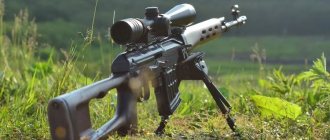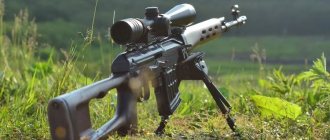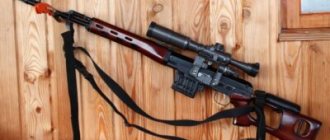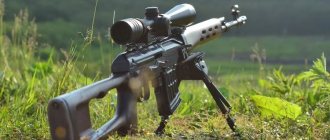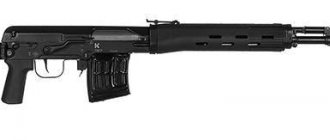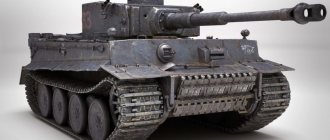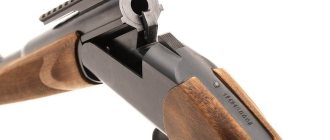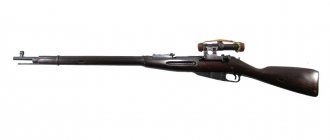The Tiger carbine is one of the examples of the so-called conversion weapons produced in the early 90s of the last century. The first samples of the "Tiger" were an SVD combat sniper rifle with a shortened barrel and a removed bayonet mount. But during the production process, the Tiger hunting carbine was increasingly “fenced” and as a result acquired modern forms.
In recent periods of production, the carbine was produced in several versions, differing in barrel length, finish, material of the forearm and butts, as well as caliber. One thing has remained unchanged: the high reliability and unpretentiousness of this weapon, inherited from its military ancestor.
Design and operating principle
The Tiger carbine is a self-loading weapon that works on the principle of removing part of the powder gases from the barrel. The barrel is locked by turning the bolt.
The rifle consists of the following parts:
- Rifled barrel, with chamber and front sight block. At its ends there are threads for attaching it to the receiver and for installing a flash suppressor. The flame arrester is used either slot-type or conical. The barrel is rigidly fixed in the receiver.
- The gas mechanism is designed to remove gases from the barrel bore. Consists of a gas tube and a piston.
- The receiver contains: the bolt frame, the return spring and the trigger mechanism.
- Box magazine for 5 or 10 rounds.
- Butt.
To make it easier to hold when shooting and to protect the skin of your hands from burns, the weapon has a forend in the form of two plates covering the gas tube and barrel.
The material for making the linings is plywood, valuable wood or polyamide, depending on the design and delivery set of the carbine.
The carbine stock is available in several versions:
- skeletal type, with a pistol grip, SVD-type;
- anatomical, with a hole for the thumb;
- hunting, with a pistol neck;
- metal, folding, frame type, SVD-S type;
It should be noted that the Tiger hunting rifle is also available in a manual reloading version. In this case, the gas tube is plugged, and the bolt frame is moved manually by the shooter after the shot.
The magazine is box-shaped, detachable. Capacity: 5 or 10 rounds.
The original Tiger carbine magazines are made of metal, but lighter polyamide box magazines of various capacities are available for sale.
After minor modifications, it is possible to use SVD magazines.
Mini video review:
Sighting devices consist of an open sight, depending on the model, notched at 300-1200 m, a front sight in a closed block and a dovetail bracket for installing optical and night sights.
Automation operation
When fired, part of the powder gases passes through a hole in the wall of the barrel bore and acts on the gas piston of the bolt frame. The piston pusher moves back under gas pressure, pushing the bolt frame. When the bolt turns and moves back, the ejector pulls the cartridge case out of the chamber and throws it out of the weapon.
The bolt frame, moving backward, cocks the firing mechanism. Upon reaching the extreme point of recoil of the bolt frame, it is affected by the force of the compressed return spring. This force pushes the frame forward; as it moves, the bolt rotates and captures the next cartridge in line from the magazine. Having loaded the cartridge into the chamber, the bolt is turned all the way, locking the barrel.
The weapon is ready for the next shot.
Operating principle
The carbine operates on the principle of removing part of the powder gases from the barrel:
- Above the barrel there is a gas cylinder, inside of which there is a gas piston.
- Powder gases from the barrel enter the gas cylinder through the hole and push the gas piston, which acts through the rod on the bolt frame.
- The bolt moves back, the bolt cylinder rotates and its stops disengage with the barrel breech. The spent cartridge case is ejected and the firing pin is cocked.
- The bolt, under the action of the return mechanism spring, moves forward, the cartridge is fed into the chamber, the bolt cylinder rotates and locks the bolt.
To charge the rifle, follow these steps:
- Press the magazine release and remove the magazine.
- Place the cartridges in the magazine in two rows, in a checkerboard pattern.
- Insert the magazine into the hopper.
- Remove the safety catch from the rifle, pull the bolt back vigorously and release.
- Put the safety on the carabiner.
Performance characteristics
The technical parameters of small arms depend on the length of the barrel and the type of cartridge.
The Tiger carbine is produced, depending on the type of cartridge used, with a barrel length of 530 mm (7.62x53R cartridge) and 565 mm (.30-06Sprg, .308Win and 9.3x64 cartridges).
In addition, rifles with a barrel length of 620 mm were produced upon request.
The direction and profile of the rifling in the barrel depends on the type of cartridge used.
The hunting barrel is distinguished by a control groove in the chamber, a flash suppressor-compensator and a front sight block of a different design.
The main parameters (performance characteristics) by caliber are summarized in the table:
| Characteristic | 7.62x53R | .30-06Sprg | .308Win | 9.3x64 Brenneke |
| Barrel length, mm | 530/620 | 565/620 | 565/620 | 565 |
| Total length, mm | 1095-1155 | 1115-1200 | 1115-1200 | 1115-1200 |
| Empty/loaded weight, kg (without sight) | 3,8/4,3 | 3,9/4,3 | 3,9/4,3 | 3,9/4,4 |
It should be noted that the minimum and maximum values for the total length and weight of the weapon are given; depending on the design, type of stock, presence/absence of a flash suppressor, this value may vary.
About sights and shooting distances
The target range of the SVD is 1200 m, despite this, effective shooting from it is carried out at a range of 500-600 m. Hunting cartridges are used at a range of 250-350 meters.
The sight notch on early releases of the Tiger and on modern models imitating SVD (Tiger-1 carbines, version 05) also has a notch up to 1200 meters, but do not forget that shooting at such a distance with an open sight is unproductive.
The rest of the carbine samples have a standard notch at a range of up to 300 meters.
Optical sights. To mount an optical sight, the Tiger is equipped with a dovetail rail, standard for Soviet and Russian weapons. Night sights with this type of mount can also be installed on this rail. But since this limits the possibilities of operation, various types of brackets have been developed with a dovetail mount and a transition to a Weaver or Picatinny rail. This will allow you to universalize the body kit.
When installing such an adapter bracket, you can install almost any scope on a rifle. The standard optical sights for the Tiger carbine are still PSO-1 and PO4x32.
Unfortunately, installing a body kit on the receiver cover is limited by its design; it is removable; in addition, installing a rail on the receiver will cover the open sight.
Additional body kit
In addition to various optical and night sights, the rifle can be equipped with more effective flash suppressors, including those that externally imitate a silencer. But in this case, do not forget that the manufacture and use of a silencer on a Tiger carbine is illegal.
The original receiver linings can be replaced with others equipped with Picatinny rails or a Keymod interface. In this case, it is possible to install additional equipment on the carbine. This could be a flashlight, bipod or laser laser.
Also, the stock is often tuned, since the original one is either not particularly convenient due to the lack of adjustments for the owner’s height, or has some kind of factory defect.
For example, the original rubber pad on the butt plate freezes in the cold and becomes brittle. And using a Tiger-9 hunting carbine without a shock-absorbing insert is not a good idea; in this case, it is worth purchasing a “galosh” pad made of frost-resistant rubber.
Using a sniper rifle, and the “Tiger”, despite the weakened cartridge and shortened barrel, is precisely a weapon with an accurate shot, effective when used for shooting from a rest. Therefore, you need to install a bipod for the Tiger carbine. This body kit for the Tiger carbine is useful both for target shooting and for hunting from an ambush or from ambush.
Weapon tuning
Tuning of the “Tiger” is possible only in three directions – the barrel, the fore-end and the butt. It should be noted that stores now offer a wide selection of body kits for the SVD rifle, which is also suitable for the Tiger. More effective flame arresters are installed on the barrel, but sometimes they go the other way: they install a flame arrester from the SVD or an imitation silencer for the Tiger carbine.
The original handguard covers are replaced with a keymod interface. A bipod is installed on the forend itself. The stock of the Tiger carbine is replaced to simulate the SVD, or a hunting stock is installed.
Disassembly
In order to disassemble the carbine, you need to do the following:
- Disconnect the magazine from the carbine
- Check that there is no cartridge in the chamber, to do this, move the bolt, perform a control release
- Remove the receiver cover by pressing the short lever located to the left of its buttplate
- Pull out the return spring
- Slide the bolt carrier back and remove it from the receiver
- Remove the shutter cylinder by turning it clockwise
- Pull out the safety lever
- Remove the trigger
- Remove the barrel linings by sliding the barrel lining coupling forward
- Move the gas mechanism pusher back, remove the piston from the chamber
- Remove the gas mechanism pusher assembly with the spring
- The carbine is assembled in the reverse order.
Barrel manufacturing technology
The Tiger barrel is created using the same technology as for SVD rifles. First, a high-quality steel workpiece is drilled, then the channel is reamed twice. Semi-finishing and finishing. This achieves the highest possible roughness during machining.
After this, the remaining roughness after reaming is melted by electric discharge, during the so-called electrochemical polishing process (ECP). And only then comes the time for the procedure for making rifling using electrochemical processing (ECM).
A cathode with a pattern and angle of the rifling fields is inserted into the finished polished channel. Current is passed through the cathode and coolant passes through the channel. During electrochemical processing, the metal of the workpiece is washed out according to the rifling pattern. This achieves high processing speed and purity. After making the rifling, the channel is washed, and the workpiece is externally turned to the required dimensions. Then the surface of the rifling and the channel itself are chrome-plated.
These operations made it possible to achieve high quality barrel processing and its durability.
Versions and modifications of the "Tiger"
The execution of the Tiger carbine within one modification represents the main variants of the weapon. The differences are in the shape of the butt, the material used to make the stock and butt, and the length of the barrel.
But all versions of one modification have the same caliber.
Modifications, unlike versions, differ in caliber and have an internal classification:
- carbine "Tiger-1", caliber 7.62x53R;
- Tiger-30 carbine chambered for .30-06 Sprigfield;
- Tiger-308 carbine, chambered for .308 Winchester;
- carbine "Tiger-9", chambered for 9.3x64 Brenneke.
The type of cartridge .308 and .30-06 is indicated in fractions of an inch, as indicated by the dot before the name of the caliber, translated into the metric system - this is a 7.62 mm cartridge.
They also define “long” with a 620 mm barrel, for example the “Tiger” carbine in Spanish. 05. And the “short” “Tiger” is used. 02, with a folding stock, and a barrel length of 530 mm.
Separately, we need to highlight the export version of the 1994 hunting rifle.
Self-loading rifled carbine "Tiger-California" with a short barrel. It was intended for export to the United States, and these weapons reached the domestic market in relatively small quantities. It was distinguished by a knife-shaped front sight block, without a muzzle ring, smooth barrel linings without ventilation slots, an aiming rib notched at 300 meters and the absence of a gas regulator.
Story
The history of the Tiger carbine dates back to 1963, when, under the leadership of the famous firearms designer Evgeniy Dragunov, the Dragunov sniper rifle, better known under the abbreviated name SVD, was developed and put into production. The purpose of creating the SVD rifle was to create a weapon capable of replacing the sniper rifles, which were outdated by that time, based on the Mosin rifle.
In 1969, based on the SVD rifle E.F. Dragunov created the Tiger hunting carbine. The first samples were as similar as possible to the combat samples of the SVD. Until 1992, the Tiger carbine was produced in small quantities and mainly on special orders from the USSR Ministry of Defense.
Serial production of the Tiger carbine began at the Izhevsk Machine-Building Plant (Izhmash) in 1992; currently the Izhmash plant is part of Kalashnikov Concern JSC.
In 1996, the first modification of the carbine was created, which received the designation “Tiger-01”; it was designed for sale on the American market and was adapted to its requirements.
In all subsequent years, the plant launched into production new modifications of the Tiger carbine, which differ from each other in the type of stock, barrel length and other design differences. In addition to the production of the Tiger carbine chambered for 7.62x54, the plant also mastered the production of carbine chambered for .308 Win, .30-06 Sprg and 9.3x64 mm.
Advantages and disadvantages
The main advantage of the “Tiger” is its brutal appearance, its resemblance to the legendary SVD. The rest of its advantages are hidden in the design itself. It is based on a military rifle, which was intended for use in very difficult conditions. Hence its reliability and resistance to contamination.
Its “omnivorousness” can also be considered an advantage. Designed for the welt cartridge mod. 1908 "Tiger" can use both Barnaul hunting cartridges and those produced in Novosibirsk.
Moreover, it can also be fired with live ammunition; the best efficiency is achieved when firing PS cartridges and heavy D bullets.
But LPS and P showed not so high efficiency. The carbine also works well with imported cartridges, both Finnish 7.62x53R welt and Winchester and Springfield inch calibers.
The main disadvantage is the barrel inherited from the SVD, or rather its mounting in the receiver. Rigid mounting of the barrel instead of hanging it is well suited for a mass-produced sniper rifle, but is not suitable for targeted shooting. In addition, it is inconvenient to shoot from hand, the 5-round magazine is too short to hold, and gripping the forend is uncomfortable. But from a rest or bipod, an unfired barrel shows very good accuracy.
Advantages
- The design of the Tiger carbine is old, time-tested, simple and highly reliable.
- Hunters note the good softness of the trigger of the carbine; such a trigger allows even novice hunters to shoot with good accuracy.
- The low price of the carbine, especially in comparison with foreign analogues, is still the main argument in its favor.
